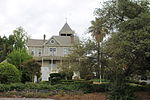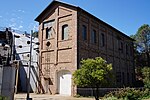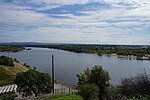Southern Pacific Railroad Section Superintendent House
American Craftsman architecture in CaliforniaBuildings and structures in Folsom, CaliforniaBungalow architecture in CaliforniaCalifornia stubs

The Southern Pacific Railroad Section Superintendent House located in Folsom, California is a historic company housing building built by the Southern Pacific Railroad for the section superintendent and his family that oversaw the Folsom junction railroad operations. The house was in use as the superintendent's house until the 1950, and as a residence until 2002.
Excerpt from the Wikipedia article Southern Pacific Railroad Section Superintendent House (License: CC BY-SA 3.0, Authors, Images).Southern Pacific Railroad Section Superintendent House
Oakdale Street, Folsom
Geographical coordinates (GPS) Address Nearby Places Show on map
Geographical coordinates (GPS)
| Latitude | Longitude |
|---|---|
| N 38.669722222222 ° | E -121.18194444444 ° |
Address
Oakdale Street 836
95630 Folsom
California, United States
Open on Google Maps






